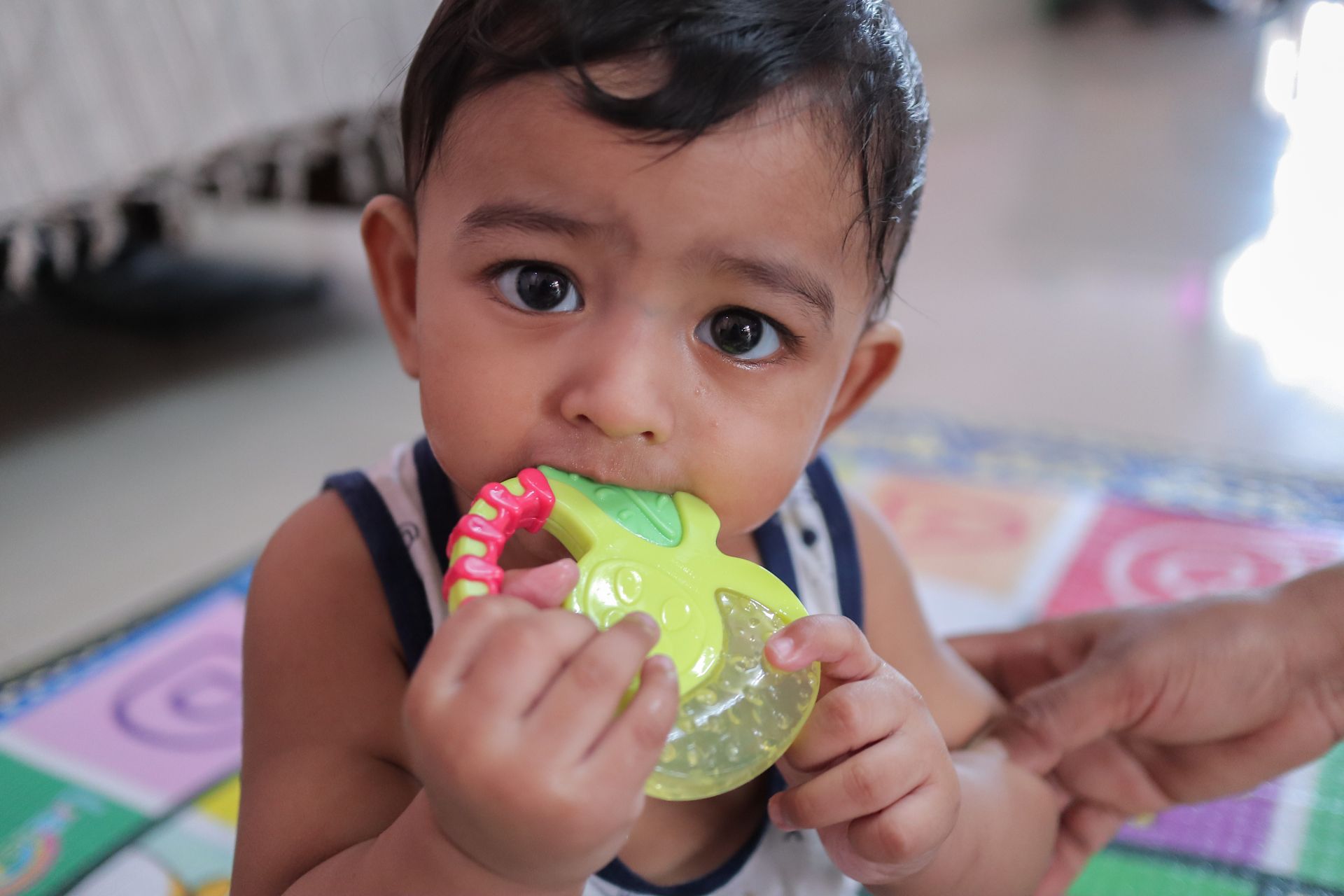Biting In The Classroom
Helping Early Childhood Educators Respond to Biting with Confidence
Biting is one of those behaviors that can send even the most experienced early childhood educators into a tailspin. It happens quickly, it hurts, and it raises questions for parents and teachers alike: “Why did it happen?” “How can I prevent it next time?” and “What strategies actually work?” If you’ve ever felt overwhelmed by biting incidents in your classroom, you’re not alone—and there’s hope (and a toolbox of strategies) ready for you to explore.
In this guide, we’ll explore why biting happens, how to respond in the moment, and proactive strategies—framed through an inclusive lens that honors every child’s unique needs.
Why Biting Happens (It’s Not “Bad Kids”)

First things first: biting is common, especially between ages 1 and 3, when children are still mastering language, self regulation, and social skills. In fact, research shows that 30–50% of toddlers in group care will bite or be bitten at some point. Biting doesn’t mean a child is aggressive or “bad”—it’s how young children express needs they can’t yet put into words. Biting is communication. For a look at the developmental roots of biting and how adults can respond, organizations like Zero to Three offer research-backed insights that can help us reframe biting as a teachable moment.
Here are some of the most common reasons young children bite:
-
Sensory Needs: Many kids crave oral-motor input. Think of how adults chew gum or crunch on pretzels. Little ones bite for the same reason—sometimes simply because it feels good, or to relieve discomfort on their gums from teething.
-
Big Emotions: When frustration or excitement skyrockets, and their words don’t come out fast enough, some children resort to biting. Their body reacts before the “language” or “thinking” part of the brain kicks in. Biting becomes an instant, physical outlet for that flood of emotion.
-
Curiosity: Toddlers are mini-scientists, testing cause and effect (“What happens if I bite?”) and imitating what they see other children do.
-
Communication Gaps: A bite can mean “Notice me,” “It’s my turn,” or “Please stop,” especially when children haven’t yet learned words or gestures to express needs.
Ready to dive deeper? If you’re looking for step by step guidance, real world scenarios, and downloadable resources, IMPACT’s on-demand course Bye-Bye Biting has you covered. And through the end of summer, it’s bundled with our Shadowing course at a special discounted rate on both courses in the Toddler Summer Bundle—your all-in-one toolkit for a smoother, safer classroom.
In-the-Moment Response to Biting
How you handle a bite can determine whether it becomes a pattern. Your calm, consistent response models regulation and teaches safer communication.
Picture this scene: Two toddlers reach for the same block. Tension sparks, and suddenly—ouch! You take a deep breath, calmly separate the children, and kneel beside them. Here are some steps to take:
Picture this scene: Two toddlers reach for the same block. Tension sparks, and suddenly—ouch! You take a deep breath, calmly separate the children, and kneel beside them. Here are some steps to take:

1. Ensure Safety. Gently separate the children if needed.
2. State the Limit. “No biting. Biting hurts.” Keep your tone firm but kind. You’re aiming for a calm but serious tone.
3. Comfort & Connect. Attend first to the bitten child—offer a hug, soothing words, or first aid. Then turn your attention to the child who did the biting: “You wanted that block. It’s okay to be mad, but biting is not okay.” The goal here is to acknowledge their feelings (I see you’re upset) and set the boundary again (no biting).
4. Gather Clues. Note what led up to the incident—time of day, activity, environmental factors—to identify triggers and patterns and guide your next preventive move.
2. State the Limit. “No biting. Biting hurts.” Keep your tone firm but kind. You’re aiming for a calm but serious tone.
3. Comfort & Connect. Attend first to the bitten child—offer a hug, soothing words, or first aid. Then turn your attention to the child who did the biting: “You wanted that block. It’s okay to be mad, but biting is not okay.” The goal here is to acknowledge their feelings (I see you’re upset) and set the boundary again (no biting).
4. Gather Clues. Note what led up to the incident—time of day, activity, environmental factors—to identify triggers and patterns and guide your next preventive move.
When a bite does occur, your response sends a powerful message. By combining safety, simple limits, and empathy, you model emotional regulation and teach effective communication. This reinforces boundaries without shame.
Inclusive Classroom Strategies to Prevent Biting
Preventing biting means meeting children’s needs before they reach the tipping point. Here are some classroom-tested strategies that work for children of all abilities:
-
Offer Oral Sensory Tools
- Stock refrigerated teethers, chewy necklaces, or age appropriate crunchy snack so sensory-seeking kids have safe outlets.
-
Build Predictable Routines
- Maintain consistent meal, play, and nap times. Adjust the schedule if you notice a child biting during “hangry” moments.
- Encourage families to share home routines: knowing if a child skipped breakfast or had a rough night can help you anticipate their needs.
-
Teach Words & Gestures
- Model exact phrases: “My turn,” “That’s mine,” or “Help me.”
- Using visuals or simple sign language for children with communication delays (like teaching kids to hold out their hand in a “Stop” gesture) is an essential inclusion strategy.
-
Design an Inclusive Environment
- Use shadowing to stay close enough to intervene and guide children toward appropriate behavior before a bite happens.
- Arrange centers and circle time seating to reduce crowding, giving a bit more personal space for children who need it.
-
Embed Social Emotional Learning
- Read books like Teeth Are Not for Biting by Elizabeth Verdick or No Biting, Louise! by Margie Palatini and Matthew Reinhart to spark conversations about safe behavior.
- Use games (like Simon Says, Red Light/Green Light) to help strengthen impulse control.
Ready to Transform Your Classroom this Summer?
Supercharge your summer professional development with our Toddler Summer Bundle—save 30% on two on demand courses! Dive into Bye Bye Biting – Strategies for Prevention and Response to learn evidence based techniques for preventing and responding to biting incidents, then master proactive support with Shadowing to Prevent Challenging Behavior, where you’ll discover how strategic adult proximity can transform toddler behavior.
Whether you’re a seasoned teacher or new to the classroom, these engaging, expert led courses will equip you with practical tools, real world examples, and downloadable resources you can implement immediately. Don’t miss this limited time offer—Enroll in the Toddler Summer Bundle today and start feeling confident the next time a bite happens!
Whether you’re a seasoned teacher or new to the classroom, these engaging, expert led courses will equip you with practical tools, real world examples, and downloadable resources you can implement immediately. Don’t miss this limited time offer—Enroll in the Toddler Summer Bundle today and start feeling confident the next time a bite happens!
Final Thoughts
Supporting young children through behaviors like biting isn’t just about reacting in the moment—it’s about creating a classroom environment where children feel safe, understood, and guided toward positive behaviors. These early years are full of big transitions and learning curves for both children and educators, and biting is often a developmental part of that journey. With consistent, flexible strategies grounded in an understanding of each child’s unique needs, educators can reduce biting incidents, strengthen relationships, and foster a more inclusive classroom. By taking time to reflect, learn, and implement small shifts in practice, you’re building the foundation for healthy communication and connection—for every child.
- The IMPACT Team
- The IMPACT Team
Note: Course links and offers mentioned in this post may have changed since publication.
To see what’s currently available, visit our course library.
Want to learn more about trauma? Sign up to be notified when our trauma training launches later in 2025!
If you're interested in learning more about supporting children of all abilities in your classroom, check out these courses:
Check out our bundles for extra savings!
IMPACT™ content is developed by a multidisciplinary team and makes every effort to ensure that information provided reflect evidence-based, early childhood best practices. Providers should always follow local jurisdictions and other governing bodies rules and regulations when implementing any strategy or suggestion. Any actions, or lack of actions, are not the responsibility or liability of Northwest Center Kids – IMPACT™.
All content, including the presentation thereof on this web site, is the property of Northwest Center IMPACT™, and protected by U.S. and international copyright laws. You may not copy, reproduce, distribute, transmit, modify, create derivative works, or in any other way exploit any part of copyrighted material without the prior written permission from Northwest Center.
All content, including the presentation thereof on this web site, is the property of Northwest Center IMPACT™, and protected by U.S. and international copyright laws. You may not copy, reproduce, distribute, transmit, modify, create derivative works, or in any other way exploit any part of copyrighted material without the prior written permission from Northwest Center.
Connect
-
Seattle, WA
-
impact@nwcenter.org
-
NWC Home
Policy pages
Subscribe & stay up to date
Thank you!
Copyright © 2025
IMPACT™ content is developed by a multidisciplinary team and makes every effort to ensure that information provided reflect evidence-based, early childhood best practices. Providers should always follow local jurisdictions and other governing bodies rules and regulations when implementing any strategy or suggestion. Any actions, or lack of actions, are not the responsibility or liability of Northwest Center Kids – IMPACT™. All content, including the presentation thereof on this web site, is the property of Northwest Center IMPACT™, and protected by U.S. and international copyright laws. You may not copy, reproduce, distribute, transmit, modify, create derivative works, or in any other way exploit any part of copyrighted material without the prior written permission from Northwest Center.
